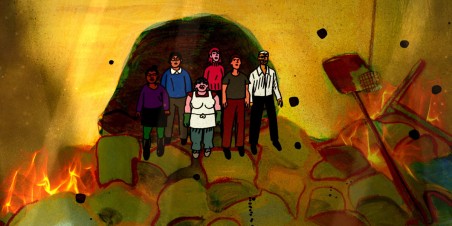Admittedly, I haven’t been great about keeping up with the Monthly Roundup feature. I like having an overview of the fat characters I’m exposed to as part of my regular moviegoing, but something about its current format doesn’t feel quite right, and I’ve decided to shelve it until I’m more confident about what I’m doing with it. However, I’m pleased to report that in the space of one short month (admittedly not a calendar month, but still), I have seen no less than four films with kickass fat female characters. Most amazingly, I only sought out one of the four because I knew in advance that it had a fat female character; the others were complete surprises. Check these out if you’re able.
Deidre and Laney Rob a Train (2017, dir. Sydney Freeland)
It’s not uncommon for a socially awkward protagonist high school girl to have a frenemy, someone in her social circle who is overly assertive and selfish, but gets away with it because of her social capital and ability to be manipulative. (Mean Girls. If it’s not patently obvious, I’m referencing Mean Girls.) In a subplot, Laney (Rachel Crow) is strong-armed into auditioning for a beauty pageant by Claire (Brooke Markham), a Lady Macbeth-in-training who is determined to become Miss Iowa and wants Laney to make her look better by comparison. Claire is ruthless, ambitious, struts around with a cute boy on her arm, and the film never so much as comments on the fact that she’s bigger than the other girls in the competition. I don’t automatically cotton to fat female antagonists for merely existing, but considering that Claire’s threat to Laney is fueled by her confidence, social prowess, and beauty, it’s heartening that the role was given to a larger-bodied actress.
GLOW: The Gorgeous Ladies of Wrestling (2012, dir. Brett Whitcomb)
A compelling documentary about the Gorgeous Ladies of Wrestling, a short-lived tv phenomenon in the late 80s that helped legitimize women in the world of professional wrestling. The film basically opens with footage from the tv show of two fat women, Mountain Fiji (Emily Dole) and Matilda the Hun (Dee Booher) throwing down in the ring. Although the other GLOW members featured in the documentary are thin and conventionally good-looking, Mt. Fiji and Matilda also stand out for their dedication to their craft. The other women talk about their time with GLOW as a fun adventure they had in their youth, mostly sending them on to other careers. As Matilda the Hun, a “glamazon” heel, Booehr views wrestling as her vocation, having struggled to wrestle in male-dominated venues long before being hired by GLOW, and continuing to wrestle long after it ends. Dole, a former Olympic-level shot putter, doesn’t have a story quite as happy as the others– the present-day segments show her struggling with health problems– but her reunion with the rest of the GLOW cast shows that not only was she one of the main faces on the show, but that her castmates truly looked up to her as the heart of the phenomenon.
A scripted series based on GLOW is releasing this summer on Netflix… we’ll see if they fuck it up, I guess!


My Entire High School Sinking Into the Sea (2017, dir. Dash Shaw)
I went into the theater thinking that the title was metaphorical, and I was dead wrong. Daria meets The Poseidon Adventure, with an inventive visual style along the lines of of Belladonna of Sadness. Dash (Jason Schwartzman), our protagonist, is a self-centered sophomore who sees himself as the star journalist of the school’s newspaper. He makes several comments about his best friend Assaf (Reggie Watts) being fat, but Assaf’s character design isn’t markedly different from the other not-fat characters. Lunchlady Lorraine (Susan Sarandon), however, is drawn fatter than the other characters, and her size belies remarkable strength and ability.

Patti Cake$ (2017, dir. Geremy Jasper)
An underdog story about Patricia “Killa P” Dumbrowski (Danielle Macdonald), a young woman from a working class town in northeast New Jersey who dreams of making it as a rapper. Her best friend Jheri (Siddharth Dhananjay) encourages her to share her talent with the world, but she feels held back by a host of reasons, including her peers who deride her for her size. Fatphobia isn’t the only problem she faces, though, and she channels her feelings her body– both anger at her haters and defiant pride in herself– into her lyrics.
Deidre and Laney Rob a Train and GLOW: the Gorgeous Ladies of Wrestling are on Netflix, My Entire High School Sinking into the Sea is currently in theaters, and Patti Cake$ is due for a wide release in July (I got to see it early thanks to the Chicago Critics Film Festival).













